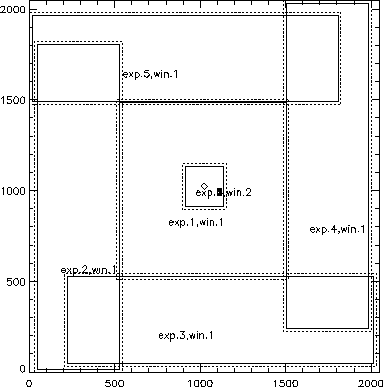Next: 3.5.9.3 Integration time for exposures Up: 3.5.9 OM Operating modes and filters configuration Previous: 3.5.9.1 OM operating modes
To ease the use of the OM and to maximise the scientific yield of observations in cases when no particular instrument configuration is requested, OM default configurations have been defined. There is one type of default configuration per OM observing mode, thus one for the imaging mode and one for the Image plus Fast mode (§ 3.5.9.1). Default windows have also been predefined for the V and UV grisms exposures. Moreover, two additional full frame modes are available which allow imaging observation of the whole OM field of view.
The possible configurations are as follows:
 |
Up to five windows (two of them in Fast mode) covering different areas of the detector can be defined (see Sect. 3.5.10.1).
It is possible to obtain images of the
whole OM field of view in full (high) or 2 2 binned (low) resolution.
These modes do not allow tracking (see § 3.5.4),
and have higher instrumental
overheads than the Modes using windows, either User Defined windows or
Imaging Mode default. However, they allow homogeneous
sampling of the whole OM field of view. They are therefore
particularly well suited for survey studies or to obtain
multiobject grism spectroscopy in a wide field.
These modes have a single window, no other window can be defined (either
in image or Fast mode) within the same exposure. Along an observation,
Full-Frame imaging modes can be combined with modes using windows
that require Field Acquisition (FAQ, see § 3.5.8),
particularly Fast mode windows. In this case the Full-Frame exposures
must be performed after all the exposures which need FAQ, because
Full-Frame modes nullify the results of FAQ.
2 binned (low) resolution.
These modes do not allow tracking (see § 3.5.4),
and have higher instrumental
overheads than the Modes using windows, either User Defined windows or
Imaging Mode default. However, they allow homogeneous
sampling of the whole OM field of view. They are therefore
particularly well suited for survey studies or to obtain
multiobject grism spectroscopy in a wide field.
These modes have a single window, no other window can be defined (either
in image or Fast mode) within the same exposure. Along an observation,
Full-Frame imaging modes can be combined with modes using windows
that require Field Acquisition (FAQ, see § 3.5.8),
particularly Fast mode windows. In this case the Full-Frame exposures
must be performed after all the exposures which need FAQ, because
Full-Frame modes nullify the results of FAQ.
The lack of tracking in Full Frame mode does not affect the quality of the image because, as experience has shown us, the drift of the XMM-Newton spacecraft is almost negligible (less than one arc sec per hour).
 17') OM FOV. Each exposure having 2 windows.
17') OM FOV. Each exposure having 2 windows.
 2'
high resolution imaging mode window is observed in all the exposures.
The continuous exposure of the central window, ensures continuous
monitoring of the prime
target (at the centre of the FOV; see Fig. 112).
2'
high resolution imaging mode window is observed in all the exposures.
The continuous exposure of the central window, ensures continuous
monitoring of the prime
target (at the centre of the FOV; see Fig. 112).
 0".5)
while the lateral windows have 2
0".5)
while the lateral windows have 2 2 in-memory
pixel binning (1”.0 pixels)
2 in-memory
pixel binning (1”.0 pixels)
 23 in-memory pixels (10”.5
23 in-memory pixels (10”.5 10”.5).
It is responsibility of the PI to carefully check the
accuracy of the target coordinates, to avoid substantial flux
losses.
10”.5).
It is responsibility of the PI to carefully check the
accuracy of the target coordinates, to avoid substantial flux
losses.
Two standard configurations are available for OM optical or UV grisms:
Examples of the Imaging and Fast default modes are shown in Figs. 112 and 113.
Apart from the configuration of the OM exposures, exposure times and
filters have to be specified.
The described Default configurations for Imaging and Fast modes provide a
very simple and easy to use set-up aimed at obtaining a good coverage of the
main target located at the boresight and imaging at the same time the complete
field of view (92% with 5 consecutive exposures).
However, due to the limitations imposed by the coincidence losses in the detector these Default configurations are not recommended in case of bright sources and in variability studies. As explained in section 3.5.5, the coincidence losses (and their correction) depend on the frametime. The different detector windows defined for the five exposures of the Default configuration may have very different frametimes leading, for high count rates, to very large and inhomogeneous corrections and errors. It is better in these cases to select a unique window using Science User Defined mode.
Observers should be aware that accurate target coordinates are important when using the fast mode, to ensure optimum centring of the source in the small fast mode window. Nevertheless, users should also be aware that occasional failure of the initial field acquisition (FAQ) exposure, and also, sometimes, spacecraft drift during long observations, can also lead to targets being notably displaced from the window centre, which can impact on the consistency of the photometry between exposure and even introduce spurious variability in the most extreme cases. These points are described in more detail in CAL-TN-0224.
European Space Agency - XMM-Newton Science Operations Centre